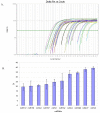Deep sequencing identifies novel and conserved microRNAs in peanuts (Arachis hypogaea L.)
- PMID: 20047695
- PMCID: PMC2826338
- DOI: 10.1186/1471-2229-10-3
Deep sequencing identifies novel and conserved microRNAs in peanuts (Arachis hypogaea L.)
Abstract
Background: MicroRNAs (miRNAs) are a new class of small, endogenous RNAs that play a regulatory role in the cell by negatively affecting gene expression at the post-transcriptional level. miRNAs have been shown to control numerous genes involved in various biological and metabolic processes. There have been extensive studies on discovering miRNAs and analyzing their functions in model species, such as Arabidopsis and rice. Increasing investigations have been performed on important agricultural crops including soybean, conifers, and Phaselous vulgaris but no studies have been reported on discovering peanut miRNAs using a cloning strategy.
Results: In this study, we employed the next generation high through-put Solexa sequencing technology to clone and identify both conserved and species-specific miRNAs in peanuts. Next generation high through-put Solexa sequencing showed that peanuts have a complex small RNA population and the length of small RNAs varied, 24-nt being the predominant length for a majority of the small RNAs. Combining the deep sequencing and bioinformatics, we discovered 14 novel miRNA families as well as 75 conserved miRNAs in peanuts. All 14 novel peanut miRNAs are considered to be species-specific because no homologs have been found in other plant species except ahy-miRn1, which has a homolog in soybean. qRT-PCR analysis demonstrated that both conserved and peanut-specific miRNAs are expressed in peanuts.
Conclusions: This study led to the discovery of 14 novel and 22 conserved miRNA families from peanut. These results show that regulatory miRNAs exist in agronomically important peanuts and may play an important role in peanut growth, development, and response to environmental stress.
Figures



Similar articles
-
Identification and characterization of microRNAs from peanut (Arachis hypogaea L.) by high-throughput sequencing.PLoS One. 2011;6(11):e27530. doi: 10.1371/journal.pone.0027530. Epub 2011 Nov 16. PLoS One. 2011. PMID: 22110666 Free PMC article.
-
Mining, identification and function analysis of microRNAs and target genes in peanut (Arachis hypogaea L.).Plant Physiol Biochem. 2017 Feb;111:85-96. doi: 10.1016/j.plaphy.2016.11.018. Epub 2016 Nov 24. Plant Physiol Biochem. 2017. PMID: 27915176
-
Deep sequencing discovery of novel and conserved microRNAs in trifoliate orange (Citrus trifoliata).BMC Genomics. 2010 Jul 13;11:431. doi: 10.1186/1471-2164-11-431. BMC Genomics. 2010. PMID: 20626894 Free PMC article.
-
Identification of miRNAs linked to peanut nodule functional processes.J Biosci. 2020;45:62. J Biosci. 2020. PMID: 32385221
-
Stress-responsive miRNAome of Glycine max (L.) Merrill: molecular insights and way forward.Planta. 2019 May;249(5):1267-1284. doi: 10.1007/s00425-019-03114-5. Epub 2019 Feb 23. Planta. 2019. PMID: 30798358 Review.
Cited by
-
Deep sequencing and microarray hybridization identify conserved and species-specific microRNAs during somatic embryogenesis in hybrid yellow poplar.PLoS One. 2012;7(8):e43451. doi: 10.1371/journal.pone.0043451. Epub 2012 Aug 29. PLoS One. 2012. PMID: 22952685 Free PMC article.
-
Identification and expression analysis of microRNAs and targets in the biofuel crop sugarcane.BMC Plant Biol. 2010 Nov 24;10:260. doi: 10.1186/1471-2229-10-260. BMC Plant Biol. 2010. PMID: 21092324 Free PMC article.
-
Novel and conserved heat-responsive microRNAs in wheat (Triticum aestivum L.).Funct Integr Genomics. 2015 May;15(3):323-48. doi: 10.1007/s10142-014-0421-0. Epub 2014 Dec 6. Funct Integr Genomics. 2015. PMID: 25480755
-
Identification of MicroRNAs in Meloidogyne incognita Using Deep Sequencing.PLoS One. 2015 Aug 4;10(8):e0133491. doi: 10.1371/journal.pone.0133491. eCollection 2015. PLoS One. 2015. PMID: 26241472 Free PMC article.
-
Genome-Wide Analysis of MicroRNA Responses to the Phytohormone Abscisic Acid in Populus euphratica.Front Plant Sci. 2016 Aug 17;7:1184. doi: 10.3389/fpls.2016.01184. eCollection 2016. Front Plant Sci. 2016. PMID: 27582743 Free PMC article.
References
Publication types
MeSH terms
Substances
LinkOut - more resources
Full Text Sources
Other Literature Sources
Research Materials

